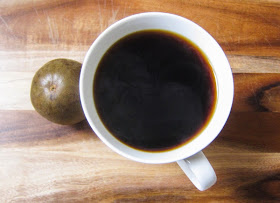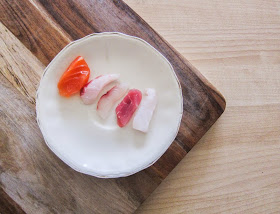 |
| Warm pita bread at Zimari. |
Another catch-up meal, this one from late July. By then, Simon had arrived in Melbourne, and my friend June happened to have an unshakeable craving for Greek food, specifically saganaki cheese, so I suggested the three of us make our way to Zimari (268 High St, Prahran/Windsor) for lunch.
Zimari's Facebook page describes themselves as "a modern Greek Restaurant with clean, simple flavours influenced from the Greek Island of Crete."
The decor is clean and simple, too; there is an airy feeling with the space and lots of natural light during the day.
The waitress who served us suggested that we try their assortment of dips with warm pita bread. We didn't end up ordering this, however they gave us a complimentary little sample plate anyway, which was lovely, in more ways than one. The pita was gratifyingly warm, dusted with spices and dotted with olive oil. The dips - a pretty purple beetroot dip, and a pale pink taramasalata dip (made with cured fish roe) - tasted fresh, and we happily mopped it all up.
 |
| Beetroot dip and taramasalata dip, served with warm pita. |
Of course we also started with saganaki. Here, they fry it with graviera cheese, which is a specialty of Crete. It had a nice crust, texture, and the expected saltiness without being too over-the-top salty, which I appreciated.
 |
| Saganaki - grilled graviera cheese with lemon and oregano. ($12) |
Their spanakopita - which boasts a homemade pastry and a filling of spinach and mizithra cheese, another famous Cretan cheese - is also delectable.
 |
| Spanakopita - homemade pastry filled with spinach and mizithra cheese. ($9) |
For something green and healthy we had the marouli salad with mixed greens, pear, dried figs and walnuts. Nothing remarkable, but fresh and pleasant.
 |
| Marouli salad - mixed greens, pear, dried figs and walnuts. ($13) |
This stifado from their specials menu that day was homely and comforting - a braised beef stew cooked in red wine, tomato and shallots, served with potatoes on the side.
 |
| Stifado - beef braised in red wine and tomato salsa, shallots and oven potatoes. ($19) |
We really enjoyed the tigania - pork fillets in a honeyed, herbaceous lemon-mustard-oregano glaze, so charmingly sweet and tender.
 |
| Tigania - pork fillet in a lemon, mustard and oregano glaze. ($14) |
For desserts, we wandered over to the counter, where the options were explained to us. We were drawn towards the portokalopita, an orange yoghurt filo cake - something different and interesting to us. I had always associated filo pastry with crispy baked goods, but here it is soft, syrupy, and unexpectedly luscious. We went at the cake again and again with our spoons, which quickly disappeared. So glad we tried this.
 |
| Portokalopita - yoghurt, filo and orange syrup cake. ($7 by itself, $9 with ice cream) |
As we paid for our food, we had a chat with the guy behind the counter, who I think is the owner. He tells us he came here from the island of Crete, Greece, and has now lived in Melbourne for about five years. I tell him that this was my first time to Zimari, and that I wished I had discovered it sooner. Next time I'm in Melbourne and craving Greek food, I know where to go.










